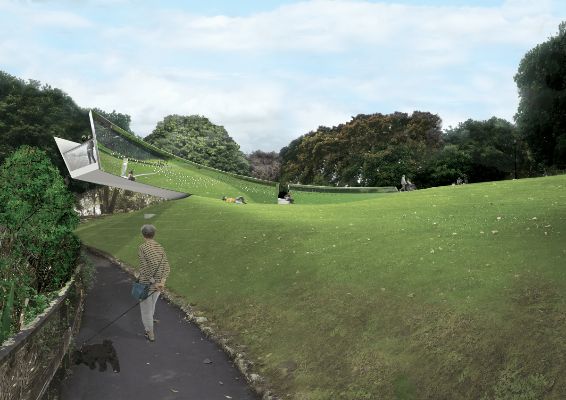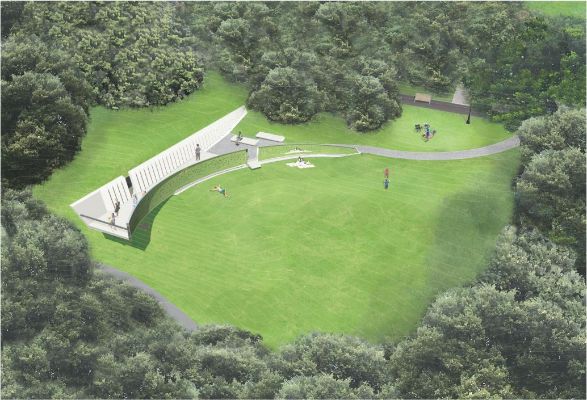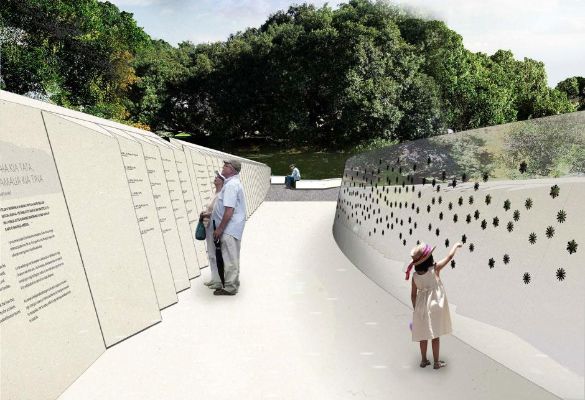On The Erebus Memorial In Parnell

Social media can be a wonderful tool for bringing people together in a common cause. It can also be a seedbed and spreader of mis-information on a community-wide scale. To which category do the protests against the siting of an Erebus memorial (to the 257 New Zealanders who died in that tragedy) in a secluded corner of a Parnell park happen to belong? IMO, it is clearly the latter, and the reasons for thinking so are explained below.
It has been alleged:
- that iwi were not properly consulted about the siting, or the design
- that the plans allegedly require the felling of an old and important pohutukawa tree nearby and/or cutting into its root system to an extent that will significantly affect the spiritual/environmental/recreational role that the tree performs within the community.
- That most of the families who lost loved ones in the tragedy do not approve of the design or its site
- that such a sombre memorial has no place in a “joyous” recreational area
- that a structure composed of concrete and stainless steel ( it has been called a “monstrosity”) has no place in such a spot.
- that other memorials to the Erebus tragedy already exist and
- that Auckland has no connection with Erebus and is therefore an inappropriate site
The major allegations on that list are demonstrably untrue, and the rest ( eg the “monstrosity” claim ) are in the eye of the beholder. But for now, let’s consider the main objections.
The Tree
It is hard to square reality with the allegations that the memorial and its construction will have a serious negative impact on the 180 (+/-) year-old tree, and on its associated eco-life. Allegedly, the pohutukawa will be felled. “This pōhutukawa is as old as Te Tiriti o Waitangi (The Treaty of Waitangi). Other notable trees would also be felled. The proposed development would forever take away a rare, precious, natural remnant of the timeless past and a continued source of wellbeing.”
Such claims are unfounded. Unfortunately, we live within our bubbles of social media, and these encourage us to consume the news that confirms our values. (It is hard to convince people who would prefer to be outraged than re-assured.) For the record, the pohutukawa will not be felled. None of the heritage trees in the area will be put at risk. At most, a few palm trees situated at a considerable distance from the pohutukawa will be removed. At the outmost edge of the memorial, the root system of the pohutukawa will be shallowly touched (if it is touched at all) by a structure that - by my reading of the map on the MCH website - sits at a distance from even the dripline of the old tree’s canopy, let alone from its trunk or central root system. This is public knowledge. As the MCH website puts it:
This drawing shows the degree to which the memorial foundation extends under the pōhutukawa dripline (the outer edge of the tree’s canopy). Excavation for this will be 1.25m long by 230mm deep. The tree trunk is approximately 20 metres from the dripline.
To repeat: the encroachment will (at most) be only 1.25 metre long and will sit shallowly on the topsoil at a depth of merely 230mm. In other words, the memorial is not remotely reliant upon the tree, its root system or its canopy for its physical supports and it will not intrude on any of the tree’s essential life processes. Any gardener who has ever grappled with the root system of a pohutukawa will know just how minimally -if at all – what is being proposed would affect the tree. (A pohutukawa is not a shrinking violet.) It should also be noted that the existing tarsealed pathway and bench are situated closer to the tree’s trunk than the memorial is proposed to be.
Moreover, the care for the tree will be ongoing and (according to MCH) any of the usual pruning will be carried out by hand, and under supervision :
All works relating to the pōhutukawa, including any pruning, soil removal or excavation, will be done by hand by a qualified arborist, under supervision [and] all construction works have been specifically designed to avoid the root system of the pōhutukawa, and it is very likely no roots will be encountered.
So… those outraged people who have posted rhetorical questions online as to why anyone would cut down such a magnificent living thing to create a memorial should relax. MCH and its contractors have never proposed to do any such thing. The more relevant question is: why have the various Facebook sites (Save Robbie’s Park, SOS NZ and Mataharehare) been willing to promote these (and other) anxiety-inducing fallacies about the memorial?
Footnote: So far, the media interest in the memorial protests has been rather limited. RNZ’s Checkpoint programme did a balanced and extensive piece in early March (see more about it below). More recently, the NZ Herald carried an article that could be regarded as a textbook example of how not to cover a controversial issue. While purporting to be reportage, it featured a single Erebus family member who opposes the project, despite the project being known to be supported by many – and probably the majority – of the Erebus families, including Maria Collins, widow of Flight 901 captain Jim Collins. None of the supportive families seem to have been contacted for comment. No comment was sought from the Ministry either, about the allegations levelled therein against the memorial.
Finally, and in the course of noting the launch of a petition against the memorial, the Herald article included a list of comments by petition signees without alerting readers that one of these ‘ordinary folks’ commenters - Jo Malcolm – has been a key organiser of the public protests against the memorial. Hey, I’m fine with advocacy journalism. Yet it needs to be done fairly, and transparently. For an alternative perspective as to why other Erebus families support the memorial, this article by Dr Richard Waugh may be useful.

The Consultation Process
For the record, the memorial process has gone through a demanding democratic process, has obtained the permits necessary to proceed, and has consulted extensively with mana whenua. Regardless, it has been claimed that the consultation with mana whenua was not conducted widely enough, lacked integrity, and was conducted without key elements of the design being revealed when initial approval was given. One of the protest leaders is Dame Naida Glavish. As mentioned above, RNZ’s Checkpoint programme recently outlined the consultation process and its relevance to the apparent conflict:
Dame Naida is from iwi Ngāti Whātua. A hapū of that iwi - Ngāti Whātua Ōrākei - is mana whenua of the area. It had been in consultation with the Ministry of Culture and Heritage on the development of the memorial since October 2018, and supported the construction. Documents from the Ministry of Culture and Heritage show extensive engagement with Ngāti Whātua Ōrākei, as well as an archaeological report in 2019 that was sent to several iwi groups. In August 2019, documents show there was also an explanation of the memorial's site and design selection process, with acknowledgement of Mataharehare and Taurarua pā, sent to 13 iwi groups with an interest in the rohe [region].
Given this track record it is hard to see how anyone – including MCH – could support Dame Naida’s unilateral contention that the hapū's approval was “effectively meaningless.” After all, the hapū concerned is mana whenua of the relevant area. Moreover, even if the hapū was initially misled– and it wasn’t – then any claimed lack of transparency about the initial memorial design or construction process (or any other aspect in dispute) would have been superseded by the hapū's latest public statement. It is worth reading in full. The statement was delivered little more than a month ago, and included this :
In terms of the proposed memorial at Taurarua (Dove Myer Robinson Park), we have reviewed the archaeological assessments and expert aborculture reports. The tupuna Pohutukawa will not be destroyed or affected – this will be retained and protected. We made sure that the location of the memorial would not damage the environment or be culturally inappropriate. As mana whenua we will ensure that the works are completed sensitively and are culturally sound. There will be further cultural narrative added to the site to ensure all whānau and visitors to the site understand the centuries of connection Māori and particularly, Ngāti Whātua Ōrākei, have to this whenua.
Ngati Whatua Orakei then addressed the protests and the failure of those opposing the memorial to produce the evidence asked of them, which had been sought in order to help the hapū to evaluate the public claims and concerns:
Unfortunately, there have been some recent public claims that there will be greater impact on the site and to the Pohutukawa tree than was shared with us through the consultation process. As a result we asked for clarification from Manatū Taonga [MCH] in relation to these claims. This has been provided. We have also asked for those making the claims to provide their evidence. This has not been provided. As a result, we remain completely in support of this very worthy and long overdue memorial.
All along, Ngati Whatua Orakei says it has felt sympathy for the families of the Erebus victims:
What is sadly lost in all of this, are the families of those tragically lost in the Erebus disaster. Since day one we have been supportive of their journey to have a place to reflect and remember. We as tangata whenua understand very deeply the need to be able to grieve and acknowledge respectfully those we have lost. We understand completely the importance of having a place of mana to be able to visit and remember our loved ones. As the Erebus whānau have chosen a site in our rohe, we will respect their wishes and ensure this is done in a culturally and environmentally safe way.
And finally, the Ngati Whatua Orakei public statement made these observations about the anti-memorial protests:
It has been clear to us that there is a campaign being run by a small number to stop the memorial. We have tried to avoid engaging in activities that are part of what seems to be a public relations campaign to stop the project. This statement is to clarify our position, to show our continued support, and will be our final public statement on the opposition to this kaupapa.
If a significant conflict exists between hapū and iwi on this matter – and it is not clear to what extent there is one – then it would be hardly appropriate for outsiders to try to resolve it.
The Memorial Design
As happens with almost any memorial, the design has not pleased everyone. Some people will continue to object to any structure being erected on this site. That’s their prerogative. Many other people in the community (including mana whenua) have reached a different conclusion. Hopefully, some critics will be open-minded enough to at least consider what the design aims to deliver to those who visit the memorial.
To that end, it may be worth pointing out that one of the most emotionally moving memorials erected during the past 100 years has been the Vietnam Veterans memorial in Washington DC, which consists of a stark, black horizontal wall on which people can touch the etched names of the Americans who died in the conflict. It, too, runs along the contours of its site and is situated in a previously remote corner of a secluded park where people did - and still do – toss Frisbees and walk their dogs. (Joy and grief can co-exist in life.) As one of the selection committee judges said during the construction phase of the Vietnam Veterans memorial: “Many people will not comprehend this memorial until they experience it.”

As the MCH website explains, visitors will be able to touch each name of the 257 people who died on the slopes of Erebus, etched into the white concrete of the Ice Wall. Alongside the names are lines from the poem Erebus Voices, composed by New Zealand poet Bill Manhire for the 25th anniversary of the accident in 2004 and read at the commemoration in Antarctica by Sir Edmund Hillary.
The opposite stainless steel Snowflake Wall will display 257 snowflake-shaped holes, unique to each person on the flight. The shape of each snowflake will be unique, since they have been digitally derived via an algorithm incorporating the names of each of the Erebus passengers. Each family will be given a replica of their loved ones’ snowflake, thereby connecting them to the site and providing them with a keepsake that can be passed on to others.
The white concrete and mirrored stainless steel materials of the memorial evoke the stark beauty of Antarctica. Adding to this, visitors within certain areas at the base of the memorial will reportedly hear ancient murmurings and sounds of Antarctica from speakers cast within the concrete. For the visitor, the experience will culminate in a view out into the open horizon – facing north, in the direction Flight 901 took before turning towards Antarctica.
No doubt, some people will continue to regard this combination of materials and design as a “monstrosity. ” Tastes differ. Conversely, many visitors will possibly respond to it with a positive outpouring of emotion and empathy. It may be relevant that during the construction phase of the Vietnam Veterans Memorial, the 21 year old architectural student Maya Lin - who designed it - was asked about what she thought the likely public response to the memorial would be :
When the wall was being constructed, the fund’s project director, Robert Doubek, asked her what she thought people would do when they first saw it. “I think he wanted me to say, ‘They’re gonna love it,’ ” Lin told the Times, when she recounted the story. “And I said something like ‘Well, I think they’re going to be really moved by it.’ What I didn’t tell him is that they are probably going to cry and cry and cry.”

Footnote : The final archaeological assessment of the site is available here. While tracking through the photos contained in that report, I noticed at page 16 a photo (called figure 14 in the text) that was taken in 1905 of Sir John Logan Campbell, his since-demolished house Kilbryde and the pohutukawa tree adjacent to it. Presumably, this is the same tree that’s currently in contention. To have pre-dated the 1840 signing of the Treaty of Waitangi, the tree would have had to be at least 65 years old (and more) in the 1905 photo. To the untrained eye, the tree looks a little younger than that. Still, no one doubts that this tree is now very old and very beautiful, and it is of significance to both of the Treaty partners. If anything, the tree’s proximity to the Erebus memorial will, over time, come to enhance the cultural significance of both the memorial, and the tree.
Footnote Two : With respect to some of the less significant criticisms mounted against the memorial such as say, why in Auckland? Well, for starters, most of the passengers came from Auckland, and the flight took off from Auckland, initially heading north. The aim has been to create a public memorial and space that’s accessible to the Erebus families, and to all New Zealanders. Yes, there are other “memorials” eg on the Erebus slopes, and in a plaque at Waikumete cemetery in Glen Eden that marks a mass grave for those unable to be separately identified. Plainly, these do not constitute a suitable and accessible memorial for a tragedy on the scale of the Erebus disaster.
Footnote Three: The Resource Consent for the project is available here. The December 2020 landowner approval letter from Auckland Council is available here. The protocols for the construction phase of the project are available here. The MCH website and the main FAQs about the memorial are available here.


 Binoy Kampmark: Commemorating Mummy - Reflections On Mother’s Day
Binoy Kampmark: Commemorating Mummy - Reflections On Mother’s Day Gordon Campbell: On The New Pope, And The Israeli Attack On Peter Davis
Gordon Campbell: On The New Pope, And The Israeli Attack On Peter Davis Martin LeFevre - Meditations: For The Love Of Sycamores
Martin LeFevre - Meditations: For The Love Of Sycamores Ian Powell: A Timely Call For A Social Contract In Health
Ian Powell: A Timely Call For A Social Contract In Health Binoy Kampmark: Bratty Royal - Prince Harry And Bespoke Security Protection
Binoy Kampmark: Bratty Royal - Prince Harry And Bespoke Security Protection Keith Rankin: Make Deficits Great Again - Maintaining A Pragmatic Balance
Keith Rankin: Make Deficits Great Again - Maintaining A Pragmatic Balance